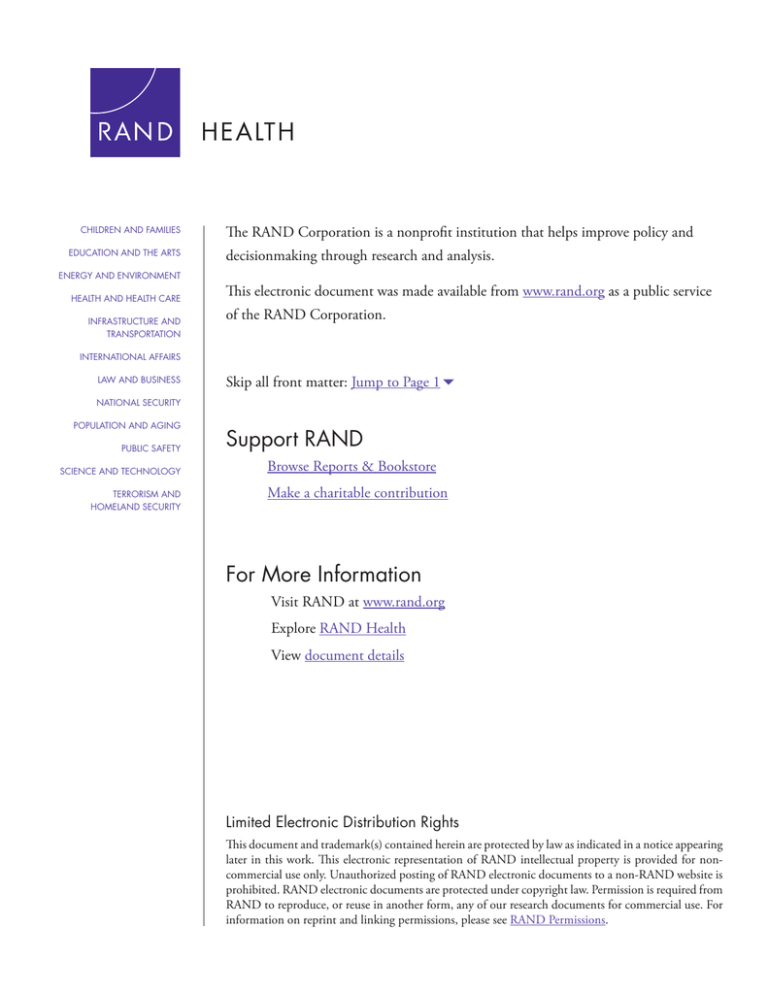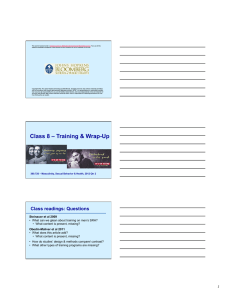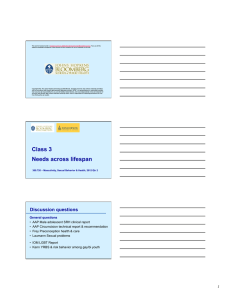The RAND Corporation is a nonprofit institution that helps improve... decisionmaking through research and analysis.
advertisement

CHILDREN AND FAMILIES EDUCATION AND THE ARTS The RAND Corporation is a nonprofit institution that helps improve policy and decisionmaking through research and analysis. ENERGY AND ENVIRONMENT HEALTH AND HEALTH CARE INFRASTRUCTURE AND TRANSPORTATION This electronic document was made available from www.rand.org as a public service of the RAND Corporation. INTERNATIONAL AFFAIRS LAW AND BUSINESS Skip all front matter: Jump to Page 16 NATIONAL SECURITY POPULATION AND AGING PUBLIC SAFETY SCIENCE AND TECHNOLOGY TERRORISM AND HOMELAND SECURITY Support RAND Browse Reports & Bookstore Make a charitable contribution For More Information Visit RAND at www.rand.org Explore RAND Health View document details Limited Electronic Distribution Rights This document and trademark(s) contained herein are protected by law as indicated in a notice appearing later in this work. This electronic representation of RAND intellectual property is provided for noncommercial use only. Unauthorized posting of RAND electronic documents to a non-RAND website is prohibited. RAND electronic documents are protected under copyright law. Permission is required from RAND to reproduce, or reuse in another form, any of our research documents for commercial use. For information on reprint and linking permissions, please see RAND Permissions. This product is part of the RAND Corporation technical report series. Reports may include research findings on a specific topic that is limited in scope; present discussions of the methodology employed in research; provide literature reviews, survey instruments, modeling exercises, guidelines for practitioners and research professionals, and supporting documentation; or deliver preliminary findings. All RAND reports undergo rigorous peer review to ensure that they meet high standards for research quality and objectivity. Nurse Practitioners and Sexual and Reproductive Health Services An Analysis of Supply and Demand David I. Auerbach, Marjorie L. Pearson, Diana Taylor, Molly Battistelli, Jesse Sussell, Lauren E. Hunter, Christopher Schnyer, Eric C. Schneider Sponsored by an anonymous private foundation HEALTH This work was sponsored by an anonymous private foundation. The research was conducted in RAND Health, a unit of the RAND Corporation. The R AND Corporation is a nonprofit institution that helps improve policy and decisionmaking through research and analysis. RAND’s publications do not necessarily reflect the opinions of its research clients and sponsors. R® is a registered trademark. © Copyright 2012 RAND Corporation Permission is given to duplicate this document for personal use only, as long as it is unaltered and complete. Copies may not be duplicated for commercial purposes. Unauthorized posting of RAND documents to a non-RAND website is prohibited. RAND documents are protected under copyright law. For information on reprint and linking permissions, please visit the RAND permissions page (http://www.rand.org/publications/ permissions.html). Published 2012 by the RAND Corporation 1776 Main Street, P.O. Box 2138, Santa Monica, CA 90407-2138 1200 South Hayes Street, Arlington, VA 22202-5050 4570 Fifth Avenue, Suite 600, Pittsburgh, PA 15213-2665 RAND URL: http://www.rand.org To order RAND documents or to obtain additional information, contact Distribution Services: Telephone: (310) 451-7002; Fax: (310) 451-6915; Email: order@rand.org Summary Nurse practitioners (NPs) are the largest subgroup of advanced practice registered nurses (APRNs), which are RNs with additional education, often including a master’s degree. APRNs also include nurse midwives, clinical nurse specialists, and nurse anesthetists. NPs, in particular, are essential providers of sexual and reproductive health (SRH) services in the United States, especially for low-income populations. A shortage of NPs has the potential to undermine the delivery of SRH care, potentially leading to worse health outcomes. Paradoxically, the gap between the supply of capable NPs and the demand for SRH services may grow under the Patient Protection and Affordable Care Act (ACA), as Americans gain health insurance coverage and NPs are diverted to the delivery of general primary care, hospital care, and specialty care. NP education has already shifted to the preparation of primary care NPs as well as NPs with gerontology expertise. These shifting priorities combined with reduced federal funding for academic and nondegree women’s health nurse practitioner (WHNP) programs have resulted in fewer NPs with entry-level clinical expertise in SRH care. This decline in WHNP graduates is especially problematic for Title X–funded clinics, which deliver a significant proportion of family planning and SRH services to low-income populations in the United States. The supply of NPs providing SRH services to low-income populations may also be threatened by the uncertain future of Title X itself. Motivated by these challenges, we sought to answer the following questions: • What is the magnitude of the future gap between the demand for SRH services and the supply of SRH services, particularly services provided by NPs? • What are the barriers to increasing the supply and use of NPs delivering high-quality SRH services? • What policy options could enhance the availability of high-quality SRH services? What is Sexual and Reproductive Health? Sexual and reproductive health (SRH) care is sometimes thought of narrowly as maternal and child health care. However, to produce optimal health outcomes, many experts believe SRH care should include the reproductive health of men and women throughout their lifespan and adolescents of both sexes. Under this definition, a minimum package of SRH care accessible to all would include preconception care, contraception, pregnancy and unplanned pregnancy care, women’s health/common gynecology care, genitourinary conditions of men, assessment of specialty gynecology problems including infertility, sexual health promotion, and coordination with public health and primary care services. xiii xiv Nurse Practitioners and Sexual and Reproductive Health Services Methods To address these questions, we first quantified likely changes in the demand for services and trends in the supply of services over the next decade. To assess demand for SRH services, we used Center for Disease Control and Prevention’s National Survey of Family Growth from 2002 to 2008 to analyze trends in use of SRH services and factors related to that use. We then projected those factors (such as age, race/ethnicity, and health insurance coverage) out to the year 2020 and derived the corresponding changes in demand for services. To assess the future supply of NPs, we analyzed data obtained from multiple sources including the HHS National Sample Survey of Registered Nurses, the American Academy of Nurse Practitioners, the Office of Family Planning’s Title X annual reports, and the National Certification Corporation (WHNP certification program). In addition, we conducted our own survey of members of the National Association of Nurse Practitioners in Women’s Health. To obtain additional quantitative and qualitative information not available from the aforementioned data sources, we conducted interviews with more than 20 experts and SRH clinic personnel. We also added questions to surveys of clinic administrators conducted by the National Family Planning and Reproductive Health Association. Based on these findings, we generated a series of policy options that could be pursued to ameliorate the gap and improve the quality of SRH care. Demand for SRH Care Overall, use of most SRH services is projected to grow by 10 percent to 20 percent between 2006 and 2020. This growth is driven largely by changes in the racial/ethnic makeup of the population of women of reproductive age and by an increase in the number of people who acquire insurance coverage because of the ACA. Those increases differ by service, with an increase of roughly 10 percent in demand expected for birth control and preventative services and roughly 15 percent growth for emergency contraception and sexually transmitted disease– related services. If the newly insured are similar to the previously insured in their tendency to seek care from specific settings, then increases in utilization at publicly funded clinics are expected to be considerably smaller than increases in utilization at nonclinic settings. If the newly insured differ in their care-seeking patterns, then increases in utilization at publicly funded clinic settings may be similar to increases in other settings. Supply of Providers of SRH Care NPs with a focus on women’s health are key providers of SRH care in Title X clinics. However, NPs specializing in SRH are a small subset of the universe of more than 130,000 NPs. Approximately 10 percent of NPs provide care in SRH settings, and only one-fifth of those (2 percent of NPs) provide care in clinic settings. However, the universe of NPs is growing rapidly and over the next decade will increase on the order of 5,000 NPs per year, or roughly 50 percent growth during that time frame. This supply would be more than adequate to meet growing demands for SRH services if NPs were to choose this area of practice in proportion to their overall numbers. Summary xv Table S.1 NPs by Population Focus and Practice Setting, 2003 and 2008 NPs with an SRH Focus Other NPs Year Total NPs WHNPs WHNPs in Ambulatory/ Community/ Public Health 2003 100,578 10,963 3,508 63,867 16,696 2008 128,288 11,674 3,362 87,492 24,507 28 6 –4 37 47 Percent increase FNP/ ANP FNPs/ANPs in Ambulatory/ Community/ Public Health However, in recent years, a combination of factors have limited the growth of supply of NPs competent in SRH care: reduced funding for WHNP training, increased funding for primary care and geriatric NP training, a shrinking proportion of NPs choosing to focus on women’s health, and a shrinking proportion of WHNPs choosing to work in public health, clinics, and family planning, as indicated in Table S.1. On the other hand, numbers of generalist NPs (family, or FNPs, and adult, or ANPs) have grown substantially and are expected to do so in the future. Thus, the shift of NPs away from a women’s health focus portends a potentially sizeable gap in the availability of SRH services relative to demand if generalist NPs prove unable to fill the gap. This gap may be particularly apparent in low-income and publicly funded clinic settings that make up a substantial part of the demand but are especially reliant on NPs for care. Barriers to Expanding the Supply of SRH Services Our interviews identified several current barriers to increasing the supply of clinicians capable of providing high-quality SRH services. These barriers include the following: • • • • • • • • • Prelicensure RN programs offer limited exposure to the topic of SRH. Nursing programs have shifted toward providing generalist education and training. A decline in the number of WHNP programs. A lack of standards for SRH core competencies and curricula. Limited opportunities for clinical training in SRH. Patchwork nursing licensure and scope-of-practice regulations. Lack of loan repayment opportunities for NPs. The fragmented nature of SRH care delivery and its isolation from primary care. Inefficiency in production of services given resources in SRH clinics. Policy Options To address the barriers that contribute to an inadequate supply of SRH-trained NPs to meet future demand for SRH services, we identified the following policy options. These options fall in to four categories. xvi Nurse Practitioners and Sexual and Reproductive Health Services 1. Education, clinical training, accreditation, and credentialing In this area, options include standardizing curricula and training, as has been achieved in other cross-cutting fields of health care such as gerontology, psych-mental health, and genetics. A core set of standards and competencies will enable development of a standard curriculum. This will allow programs to better integrate SRH and primary care training and clarify the opportunity for NPs with a potential interest in SRH. Basing certification requirements on competencies rather than other criteria could replace the restrictive pathways to certification that currently impose a barrier to some NPs seeking to obtain certification in SRH care. 2. Federal regulation and financing Federal policy influences SRH care primarily through Title X regulation of service standards tied to financing of care provided by Title X clinics. Education and training are also supported through federal programs. Options include supporting Title X clinics to take a more formal role as training and residency sites for postgraduate clinical training. The service standards defining the scope of Title X clinical offerings could be broadened to strengthen integration with primary care delivery, and Title X clinicians could be allowed to participate in federal loan forgiveness programs. SRH care could be included as a key part of the formal definitions of primary care in HRSA and CMS programs and payment policies. These actions would increase the attractiveness of SRH clinical care to NPs with an interest in SRH. 3. State regulation and financing States have a key role in defining NP employment opportunities through licensure and Medicaid payment policy. In some states, nurse practice laws currently limit the types of providers permitted to perform SRH care or state facility regulations limit SRH care integration with primary care. The Institute of Medicine has recommended reducing the restrictions imposed by some states through law and regulation. State Medicaid policy could explicitly reimburse SRH services at higher rates (within fee-for-service payment schedules) or account for SRH services in setting global payments for primary care, creating incentives or allowing special designations afforded to primary care under ACA and health insurance programs. 4. Responding to emerging models of care delivery New models of health care delivery create new policy options for increasing NP engagement in SRH service delivery. First, as accountable care organizations and other integrated models develop, several enabling actions could promote greater integration of SRH care into these models. These might include co-location of SRH-competent providers in primary care clinics such as federally qualified health centers or community health centers; expansion of retail clinics and nurse-managed health centers with SRH services; and setting payment rates based on services rather than provider type. Insurer and government payment models could explicitly incorporate SRH care and, correspondingly, SRH training could be oriented to recognize the expanding payment models and settings that can integrate and incorporate SRH care. Summary xvii The policy options listed above are partially recognized in three innovative models currently under development in the United States. In addition, we describe a model implemented by the U.K. National Health Service, which aligns SRH education and practice standards within a coordinated system of primary care and public health. In conclusion, current trends in supply and demand for SRH services, particularly for low-income individuals, suggest a growing gap in the next decade, with demand outstripping supply. The reasons for that growing gap are tied less to the production of NPs overall and more to a reduced production of NPs trained to deliver SRH care. The evolving market for health care delivery and the expanding health insurance coverage associated with the health care reform legislation of 2010 present additional challenges for SRH care but offer opportunities as well. A range of policy options have the potential not only to close expected supply–demand gaps but to improve the quality and efficiency of SRH service delivery, expand the provider base delivering SRH services, and better integrate them with other parts of the health care system.






